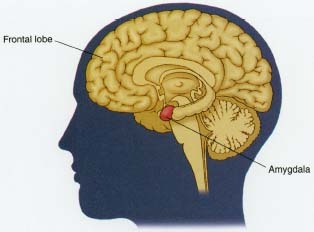Emotions

Emotions are specific and intense psychological and physical reactions to a particular event.
KEYWORDS
for searching the Internet and other reference sources
Feelings
Mood
Mood disorders
Stress
One morning Mandy waited for the light to change so that she could cross the street to school. As the light in her direction turned green, she stepped off the curb. Suddenly, Mandy froze as a car shot right past her through the red light and crashed into a car already in the intersection. Mandy was not hurt. The car that went through the red light was not that close to her, but she felt terrified, then weak and shaky. She was so upset that she started to cry. That morning at school, whenever Mandy thought about the accident she had seen she felt nervous and shaky. By lunchtime, when she talked to her friends about the accident, the shaky feeling was starting to wear off, and she was beginning to feel anger toward the driver of the car that had run the red light. Although Mandy was not physically hurt, her mind and body were experiencing a strong emotional reaction to a dangerous situation.
What Are Emotions?
Emotions, often called feelings, include experiences such as love, hate, anger, trust, joy, panic, fear, and grief. Emotions are related to, but different from, mood. Emotions are specific reactions to a particular event that are usually of fairly short duration. Mood is a more general feeling such as happiness, sadness, frustration, contentment, or anxiety that lasts for a longer time.
Although everyone experiences emotions, scientists do not all agree on what emotions are or how they should be measured or studied. Emotions are complex and have both physical and mental components. Generally researchers agree that emotions have the following parts: subjective feelings, physiological (body) responses, and expressive behavior.
The component of emotions that scientists call subjective feelings refers to the way each individual person experiences feelings, and this component is the most difficult to describe or measure. Subjective feelings cannot be observed; instead, the person experiencing the emotion must describe it to others, and each person's description and interpretation of a feeling may be slightly different. For example, two people falling in love will not experience or describe their feeling in exactly the same ways.
Physiological responses are the easiest part of emotion to measure because scientists have developed special tools to measure them. A pounding heart, sweating, blood rushing to the face, or the release of adrenaline * in response to a situation that creates intense emotion can all be measured with scientific accuracy. People have very similar internal responses to the same emotion. For example, regardless of age, race, or gender, when people are under stress, their bodies release adrenaline; this hormone helps prepare the body to either run away or fight, which is called the "fight or flight" reaction. Although the psychological part of emotions may be different for each feeling, several different emotions can produce the same physical reaction.
Expressive behavior is the outward sign that an emotion is being experienced. Outward signs of emotions can include fainting, a flushed face, muscle tensing, facial expressions, tone of voice, rapid breathing, restlessness, or other body language. The outward expression of an emotion gives other people clues to what someone is experiencing and helps to regulate social interactions.
* adrenaline (a-DREN-a-lin), also called epinephrine, (ep-e-NEF-rin), is a hormone, or chemical messenger, that is released In response to fear, anger, panic, and other emotions. It readies the body to respond to threat by increasing heart rate, breath-Ing rate, and blood flow to the arms and legs. These and other effects prepare the body to run away or fight.
What Are The Sources of Emotions?
Scientists have developed several theories about how emotions are generated based on subjective feelings, physiological responses, and expressive behavior.

The James-Lange theory
American scientist William James (1842-1910) and Danish scientist Carl Lange (1834-1900) both studied the relationship between emotion and physical changes in the body. In about 1885, they independently proposed that feeling an emotion is dependent on two factors: the physical changes that occur in the body and the person's understanding of the body's changes after the emotional event. James and Lange believed that physical changes occur first, and then interpretation of those physical changes occurs. Together, they create the emotion.
According to the this theory, when Mandy experienced a threatening situation (almost being hit by a car), her body first sent out chemical messengers, like adrenaline, that caused physical changes such as increased breathing and a faster heart rate. Her brain then sensed these physical changes and interpreted them as the emotion fear.
One of the problems with the James-Lange theory is that emotions seem to happen too quickly to be accounted for by the release of chemical messengers and the changes they cause. Another problem is that different emotions (for example fear and anger) have been shown to cause the same physical responses.
The Cannon-Bard theory
In 1927, about 40 years after the James-Lange theory was developed, Harvard physiologist Walter Cannon (1871-1945) and his colleague Philip Bard (1898-1977) developed a new theory that related the workings of the nervous system to the expression of emotions. Cannon and Bard found that people could experience emotion without getting physical feedback from chemical messengers. They proposed that upon experiencing a stimulating event, information about the event is collected by the body's senses and is sent through the nervous system to the brain.
In the brain, the message is sent two places at the same time. The message is sent to the cortex * , which creates emotions; in Mandy's case it created fear. At the same time, the message also goes to the hypothalamus (hy-po-THAL-ah-mus). The hypothalamus is the part of the brain that controls automatic body responses. It tells the body to send out chemical messengers that cause the body to respond. Some of these responses are experienced as behaviors such as shaking, rapid breathing, and crying.
The Schacter-Singer model
In 1962, American scientists Stanley Schacter (1922-1997) and Jerome Singer (still teaching at Yale University in 2000) took elements of both the James-Lange and the Cannon-Bard theories and modified them to try to better explain the relationship between physical responses and emotional experience.
* cortex is the part of the brain that controls conscious thought;it is where people experience'thinking and feeling."
According to the Schacter-Singer model, both physical changes and conscious mental processing are needed to fully experience any emotion. In this model, in response to her near-accident, Mandy's body sent out

Research continues on the relationship between the body, the brain, and the perception of emotions. One current area of research is focused on whether certain areas of the cortex are dedicated to specific emotions and whether a person can feel an emotion when a particular part of the cortex is stimulated directly by an electric impulse.
Why Do We Have Emotions?
Emotions appear to serve several physical and psychological purposes. Some scientists believe that emotions are one of the fundamental traits associated with being human. Emotions color people's lives and give them depth and differentiation. For many people, strong emotions are linked to creativity and expression. Great art, music, and literature deal on a fundamental level with arousing emotions and creating an emotional connection between the artist and the public. Some scientists also believe that emotions serve as motivation to behave in specific ways.

Physiologically, emotions aid in survival. For example, sudden fear often causes a person to freeze like a deer caught by a car's headlights. Because animals usually attack in response to motion, at its simplest level, fear reduces the chances of attack. When Mandy froze in response to a car racing by her, this was an example of a physical response to an emotion that improved her chances of survival.
Emotions also help people monitor their social behavior and regulate their interactions with others. Every person unconsciously learns to "read" the outward expressions of other people and apply past experience to determine what these outward signs indicate about what the other person is feeling. If a person sees a man approaching who is walking very aggressively, holding his body stiffly and frowning, the person might correctly assume that the man is angry. Using this information, the person can decide whether to leave or to stay or what tone of voice and body language to use when approaching the man.
Some outward expressions of emotions (body language) mean different things in different cultures. For example, if a young person avoids looking directly at a person in authority, it is taken as a sign of respect in some cultures. In other cultures, this expression suggests guilt or a lack of trustworthiness.
What is Emotional Intelligence?
Emotional intelligence refers to people's ability to monitor their own and other people's emotional states and to use this information to act wisely in relationships. Emotional intelligence has five parts:
- Self-awareness: recognizing internal feelings 1.
- Managing emotions: finding ways to handle emotions that are appropriate to the situation
- Motivation: using self-control to channel emotions toward a goal
- Empathy: understanding the emotional perspective of other people
- Handling relationships: using personal information and information about others to handle social relationships and to develop interpersonal skills
Researchers are beginning to develop tests that can measure emotional intelligence. Scientists who study emotions generally believe that people with high emotional intelligence usually work well in cooperative situations and are good at motivating and managing others. People with low emotional intelligence often misinterpret emotional signals and have difficulty with relationships. Although emotional intelligence probably has an inherited component, many psychologists believe that people can be guided into making better use of the emotional intelligence that they possess.
Resources
Books
Goleman, Daniel. Emotional Intelligence. New York: Bantam Books, 1997. This book introduced the idea of emotional intelligence to the public.
LeDoux, Joseph The Emotional Brain: The Mysterious Underpinnings of Emotional Life. New York: Simon and Schuster, 1998. This book examines the connection between physical responses and emotions.
Mackler, Carolyn. Love and Other Four-Letter Words. New York: Bantam Doubleday Dell, 2000. Young adult fiction that addresses trying to make sense of the strong emotions that occur during adolescence.
Comment about this article, ask questions, or add new information about this topic: